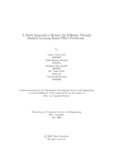A novel approach to reduce air pollution through machine learning based PM2.5 prediction
Date
2022-05-24Publisher
Brac UniversityAuthor
Alif, Omar FarhadMonsaif, Tarik Monwar
Amarth, Swakshar Das
Kabir, Md. Nafiu
Sadman, Tahmid Asif
Metadata
Show full item recordAbstract
AI (Artificial Intelligence) is one of the most fascinating subjects for computer scientists in this century. It is a technology that helps a machine to do tasks by itself which needs human intelligence. This technology reduces human error and increases the productivity of any task by a greater number of times. Nowadays AI is being used by many devices and also it has a limitless possibility to work with. As this technology grows faster scientists are combining it with various other technologies to be perfect. Cloud computing and IoT (Internet of Things) can be used in a framework for an AI to be more intelligent and give access to more data. For the past few years, only a small group of people around the world are thinking about the environment that they are living in where the environment must be the priority to think about. Air pollution is one of the causes which people are gradually becoming sick. Polluted air causes different lung diseases for which people also need to bear medical expenses. When technology is in the hands of every person, it is a must to make them aware of what they are inhaling and how they can make the world a better place. So, the answer to the question of what we are doing is that this research proposes a novel approach for reducing air pollution by making people more aware of their day-to-day life by detecting the environmental air condition with the help of machine learning by using PM2.5 prediction and computational cloud computing. As a result, we will introduce a framework that allows one to know about the air that one is inhaling and how to counter the air pollution by providing a computational output with the help of PM2.5 prediction, Computational Cloud Computing, Networking, and IoT with necessary actions with the help of some known methods such as Logistic Regression Analytics, Artificial Neural Networks, Decision Tree and Long short-term memory neural networks.

